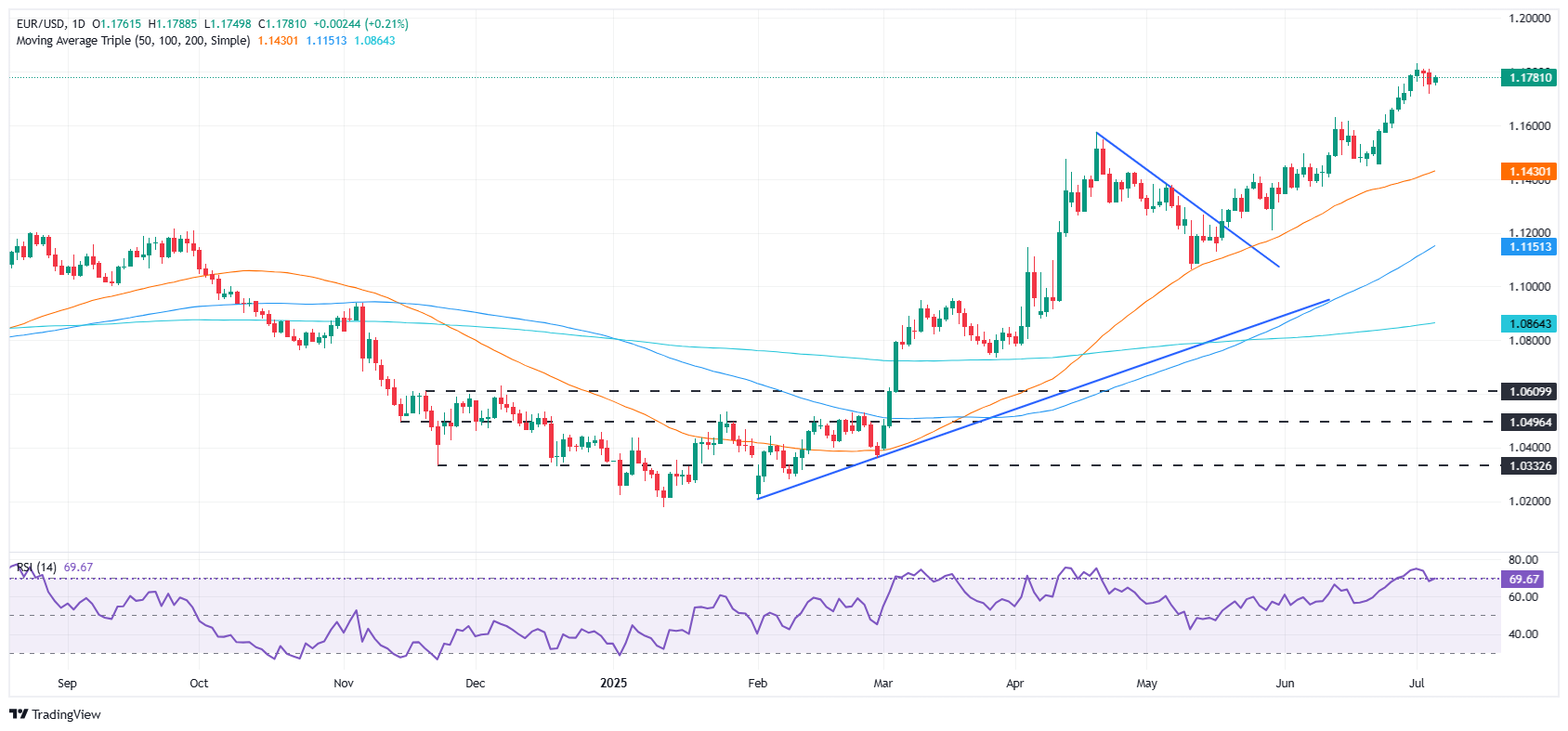- The EUR/USD advances 0.18% in a light trade while the operators digest Trump’s wide tariff plans and increase the tensions between the EU and the USA.
- Trump confirms tariffs of up to 70% that will take effect on August 1, aimed at EU products, including food.
- Bloomberg: EU car manufacturers seek tariff relief through US investment promises.
- The US light calendar displaces the approach to German industrial production and the Eurogroup meeting next week.
The EUR/USD registered minimal profits of 0.18% on Friday in the midst of thin liquidity conditions, since markets in the United States are closed due to independence day holidays. The shared currency is ready to close the week with 0.53% profits despite the publication of solid economic data from the US this week. At the time of writing, the par is quoted at 1,1778.
The economic news is scarce on Friday, however, market participants focused their attention on tariffs and the approval of the ‘One Big Beautiful Bill’ by US President Donald Trump.
On Thursday, Trump announced that the United States would begin to issue letters of declaration, notifying countries that tariffs are being applied to their goods and services. He added that tariffs could be in the range of 10% to 70% and would take effect on August 1. Meanwhile, tensions around a commercial agreement between Europe and the US are increasing, since Washington announced a 17% tariff on European foods.
Meanwhile, Bloomberg reported that “some cars manufacturers of the European Union and capitals are pressing for an agreement with President Donald Trump that would allow a tariff relief in exchange for increasing investment in the US, according to people familiar with the matter.”
The absence of an economic calendar in the US left the operators of the EUR/USD drifting while they returned to the European Union calendar (EU). German industrial orders fell below the estimates in May each month, but compared to the figures of the same month of the previous year, they showed a slight improvement.
After Monday, the EU calendar will present industrial production figures in Germany, the Eurogroup meeting, ECB speakers and the announcement of retail sales data for May.
What moves the market today: the EUR/USD rises in a light economic calendar
- The president of the USA, Trump, said that his administration would begin to notify countries about the new US tariffs for their exports, which will enter into force on August 1. He said that around ten to twelve cards would be sent on Friday. Additional letters will be distributed in the next few days, before the deadline of July 9.
- The ‘One Big Beautiful Bill’ approved by the US Congress will add 3.4 billion dollars for a decade to the national deficit. The bill aims to extend the tax cuts implemented in 2017 and assign billions of dollars to defense and application of immigration. At the same time, it cuts some medical care programs, food assistance and clean energy projects.
- A Bloomberg article revealed that the EU and the US are close to a technical commercial agreement in principle. The EU hinted that she is willing to accept a universal tariff of 10% but in exchange for lower rates in pharmaceutical products, alcohol, semiconductors and aircraft. They also look for fees and exemptions to reduce current tariffs on cars, steel and aluminum. Negotiations between both parties will continue during the weekend.
- Factory orders in Germany in May fell 1.4% intermensual from an expansion of 1.6% in April. In the twelve months until May, it decreased from 5.8% to 5.3%, revealed the Deutsche Bundesbank.
EURO TECHNICAL PERSPECTIVE: EUR/USD bounces around 1,1780 while the bulls point to 1,1800
The EUR/USD is quoting laterally on Friday and is ready to form a ‘Harami Alcista’ candle pattern, which suggests that the long -term upward trend remains intact. However, a clear rupture of the maximum of July 3, 1,1809 is needed, before trying the annual maximum of 1,1830. Once these levels are exceeded, the next stop would be 1,1850 and 1,1900.
On the contrary, if the EUR/USD falls below 1,1750, the door will open to a possible descent to 1,1700. In case of greater weakness, the next support level will be the maximum of June 12 in 1,1631.

EURO – FREQUENT QUESTIONS
The euro is the currency of the 19 countries of the European Union that belong to the Eurozone. It is the second most negotiated currency in the world, behind the US dollar. In 2022, it represented 31 % of all foreign exchange transactions, with an average daily business volume of more than 2.2 billion dollars a day. The EUR/USD is the most negotiated currency pair in the world, with an estimate of 30 %of all transactions, followed by the EUR/JPY (4 %), the EUR/GBP (3 %) and the EUR/AU (2 %).
The European Central Bank (ECB), based in Frankfurt (Germany), is the Eurozone reserve bank. The ECB establishes interest rates and manages monetary policy. The main mandate of the ECB is to maintain price stability, which means controlling inflation or stimulating growth. Its main tool is the rise or decrease in interest rates. Relatively high interest rates (or the expectation of higher types) usually benefit the euro and vice versa. The GOVERNMENT BOOK of the ECB makes decisions about monetary policy in meetings that are held eight times a year. The decisions are made by the directors of the National Banks of the Eurozone and six permanent members, including the president of the ECB, Christine Lagarde.
Eurozone inflation data, measured by the harmonized consumer prices index (IPCA), are an important economic indicator for the euro. If inflation increases more than expected, especially if it exceeds 2% of the ECB, it forces the ECB to rise interest rates to control it again. Relatively high interest rates compared to their counterparts usually benefit the euro, since they make the region more attractive as a place for global investors to deposit their money.
Published data measure the health of the economy and can have an impact on the euro. Indicators such as GDP, manufacturing and services PMIs, employment and consumer trust surveys can influence the direction of the single currency. A strong economy is good for the euro. Not only attracts more foreign investment, but it can encourage the ECB to raise interest rates, which will directly strengthen the euro. Otherwise, if economic data is weak, the euro is likely to fall. The economic data of the four largest economies in the euro zone (Germany, France, Italy and Spain) are especially significant, since they represent 75% of the economy of the euro area.
Another important fact that is published on the euro is the commercial balance. This indicator measures the difference between what a country earns with its exports and what you spend on imports during a given period. If a country produces highly demanded export products, its currency will gain value simply by the additional demand created by foreign buyers seeking to buy those goods. Therefore, a positive net trade balance strengthens a currency and vice versa in the case of a negative balance
Source: Fx Street
I am Joshua Winder, a senior-level journalist and editor at World Stock Market. I specialize in covering news related to the stock market and economic trends. With more than 8 years of experience in this field, I have become an expert in financial reporting.







